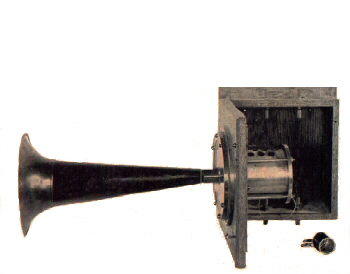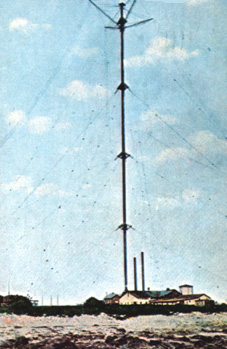
 |
. |
| The wireless telephone and the future (NRC) |
AN ARTICLE BY REGINALD FESSENDEN:
"A good deal of hard work went to the inventing of the wireless telephone: both research, going over a fishing place to find what fish are there, and invention, or deciding you want a certain fish and going after it until you get it.
"We had a good heritage. Henry had discovered magnetic induction, and that electric discharges were oscillatory and propagated in space and had shown how to detect them by his magnetic receiver; Dolbear had given us the vertical antenna, Edison the hot cathode tube. Gray had successfully transmitted pictures long distances over wire by his telautograph; Pupin had showed how important the air core was for accurate tuning; Tesla had given up his loose coupled transformer circuits for sending and receiving; and after Hertz's publications Cookes and a score of others had suggested how they should be used for signaling, and Popoff and others had made attempts to develop a system using the Henry-Hertz distinctive discharge and the Edison-Branley bad contact detector.
"But many other things were needed for wireless telephony: first a continuously acting, proportionally indicating receiver, and means for producing continuous waves. Right here, across the road, barring it, stood authority, the highest scientific authority of that day. 'Alternating currents in the vertical wire will not produce Hertzian waves in the other. Motions of some kind would be produced, but they would be of a quite different character. Hertzian waves are produced only by the disruptive discharge' testified Professor Cross of the Massachusetts Institute of Technology. 'Unless some form of condenser is discharged across a spark gap there cannot be any production of Hertzian waves' was the dictum of Professor Fleming of the University of London. 'The difference between Hertzian oscillations and ordinary alternating currents is most certainly not one of degree. It is clear to me that there is no Hertzian wave telegraphy without the essential feature for producing Hertzian waves, which is the Hertzian spark' was the testimony of Marconi, who attempted to put the disruptive spark bad contact system into commercial operation. (See court reports, Marconi vs. DeForest, Southern District of New York.)
"In the belief, founded on mathematical work done in 1890-1895, that these and other authorities, who had in 1896 imposed the 'whip-crack' doctrine on the scientific world, were wrong, and that wireless telephony, the production of continuous waves, was not only possible, but was the only way which would give a practically operative system, the years 1898 and 1899 were spent in inventing and developing a number of types of good contact, continuously operative, quantitatively responding, detectors and in making with their aid (for the first time then possible) accurate quantitative measurements of Hertzian wave phenomena, and results will be found in the Trans. American Inst. Elect. Engineers for November 1899. As bearing on the accuracy of the measurements, it will be noted that the figure there given for the width of the wave band absorbed by a vertical antenna, i.e., one-seventh of its height is in close agreement with that found by Lord Raleigh twenty years later, i.e., one divided by two pi. Work on the high frequency dynamo was begun in 1900, but instructions were not followed by the manufacturer and when delivered in 1903 it would give only 10,000 cycles. Meantime a 10,000 frequency spark gap had been built by me, and almost exactly 25 years ago, in Christmas week of 1900, the human voice was first transmitted by wireless, between two stations a little over one mile apart at Cob Point, Maryland. Poor in quality, but quite distinct and entirely intelligible. 1901-03 were spent in inventing and developing half a dozen other types of sources of continuous waves, the oscillatory waves and the regenerative (both static and magnetic) mercury vacuum tube types shown in U.S., ser. no 222, 301, Aug. 26th, 1904: the compressed nitrogen and compressed neon oscillators: the quenched gap and fly-wheel types. Four or five of these gave very good results: the Bureau of standards tests on the compressed nitrogen gap showing one-half kilowatt of pure sine continuous waves at frequencies, measures, as high as 2,000,000.
"In 1904, with a 20,000 frequency spark and compressed nitrogen gap, such good results were obtained that a demonstration was given to a number of electrical engineers, who signed affidavits that they considered the articulation as commercially good over twenty-five miles, and the sets were advertised for sale, but apparently not very effectively, if one may judge by the following letter:
U.S. Bureau of Equipment, Washington D.C., July 8th, 1905.
Sirs: We have been advertising wireless telephones for some time and on several occasions during the past year have offered to supply your department. During the course of our recent conversation I learned that these tenders had not been noted. A list is therefore submitted of various types of apparatus which we are prepared to furnish your department in lots of twenty-five or more.
Two (2) Apparatus for wireless telephony up to a distance of 10 miles or more.
Six (6) Apparatus for indicating the position and course of ships in fog within a range of three miles.Respectfully,
Reginald A. Fessenden
"But for patent reasons, resulting from the erroneous "whip crack" theory which had been adopted, very exclusively, by the courts, the high frequency alternator was a necessity, though the compressed neon tube is in some respects its superior. A second alternator was delivered in 1905 with a letter from the company which was doing the work for me, stating that in the opinion of the G.E. Company it was not possible to operate it above 10,000 cycles. Everything was scrapped but the pole pieces and a new armature, etc., built to my design, in my Washington shop. It gave 70,000 cycles and about one-half kilowatt of electric wave radiation. The problem had been solved.
| . |  |
| Fessenden's 420-foot transmitting tower at Brant Rock (The Radioscientist) |
"The working between Brant Rock and Plymouth, about eleven miles apart, was so satisfactory in every was that the following letter was sent out to a number of eminent engineers and scientists, e.g. American Telephone Journal, 100 William Street, New York City:
Brant Rock, Mass. Dec. 11, 1905
American Telephone Journal,
100 William Street, New York CityDear Sirs:
A limited number of invitations have been issued to witness the operation of the National Electric Signaling Company's wireless telephone system between Brant Rock and Plymouth, over a distance of between ten and eleven miles.
The tests will be as follows:
1. Transmission of ordinary speech and also transmission of phonographic talking and music by wireless telephone between Brant Rock and Plymouth.
2. Transmission of speech over ordinary wire to wireless station at Brant Rock, relaying the speech there automatically by telephone relay and automatically transmitting the speech by wireless to Plymouth, transmitting the same at Plymouth automatically directly or by telephone relay over regular wire line.
Invitations have been issued to the following gentlemen: Dr. A.E.Kennelly, Professor Elihu Thomson, and a request to the Journal to send a representative.
Yours very truly,
National Electric Signaling Company
"I have here a photostat of the illustrated report of the editor of the American Telephone Journal and of his editorial on this first demonstration of wireless telephone which I have pleasure in presenting to the Radio Institute library. At this time I had the great good fortune to obtain the assistance of one who is in my considered opinion the greatest electrical designer in the world: I refer to Dr. Alexanderson. He supplanted my machines with machines of his own design, much better, giving up to 200,000 cycles, and later, as you all know, he built the machinery for the first practical and commercial transatlantic working. I owe him much and in many ways.
"In 1907, wireless telephone stations were operated between Boston and New York (Brant Rock and Brooklyn) during substantially the entire year, including summer months, the transmission being better, by direct comparison, than over the wire telephone lines. Amplifiers were not used, as no advantage for commercial working, though four or five types, magnetic, the AT&T laboratories. A little later Brant Rock to Washington was worked satisfactorily, and in December 1907, the first transatlantic transmission of speech was accomplished on two occasions (see Trans. Amer. Inst. Elect. Engineers, July 8, 1908, and Scientific American, Sept. 1918). The phantom antenna was invented for working both ways, and as the result of nearly a year's test by the engineers of the AT&T and Western Electric Companies, in 1909 Mr. Fish, President of the AT&T companies wrote asking myself and partners to come on to Boston to sign a contract for the use of the wireless telephone for long distance trunk line work between Boston and Buffalo, Boston and New York, etc. We came on, only to find that at the last moment the directors had turned down Mr. Fish's arrangements.
"The work has, however, been continued. Aside from the development by the writer of his short wave and horizontal wave system, the importance of which is beginning to be appreciated (though the fact that it is only the vertical comportent that is absorbed by the Kennelly layer does not yet seem to have been noted) there have been other developments.
"There are in existence today, fully developed and tested, wireless methods for operating substantially without disturbance or interference from static, which means have been tested with large capacity high antenna between Boston and Panama, in summer. There are in existence today, fully operating direct, without exchanges, by setting direct to the subscriber's number, bodies of subscribers as large as those comprising the New York apparatus of 1906 to a device capable of putting wireless vision into every house in the United States, and was tendered to the U.S. Navy under valued function method, as it is called, and the shutter, which has been operated by independent engineers to a frequency of 400,000 per second and presenting a photograph showing the general arrangement its action, and a sample of the wire used, of which it takes 900 twisted together to make the size of a single human hair. In view of these developments, it will be understood that wireless telephony, with its 5,000,000 of sets in the United States and its mighty evening audience, must be kept open as the last door of free and unpropagandized speech: our last available means of exercising intelligently our privileges and authority as citizens of the United States. That door has been closed tonight. It must never be closed again."
Reginald A. Fessenden
45 Waban Hill Road,
Chestnut Hill, Mass.
Reprinted courtesy of Reginald Fessenden's Estate